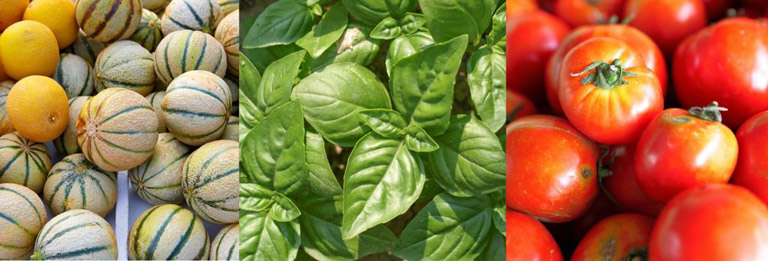Entertaining and cooking
outdoors is one of my favorite ways to show my friends a good time. Many
people associate summer parties and barbecues with less healthful food
options. But you can infuse a lot of nutritional density into your celebration
by just knowing what’s at its best right now. Look for these
7 superfoods in season for summer and kick up the nutrition at all your
summer get togethers.
7 Superfoods In Season
for Summer
Blueberries: Blueberries are
available from May through October. So they are at their peak
now. Blueberries contain a type of flavonoid known as anthocyanins, which
are responsible for giving foods like blueberries, cranberries, red cabbage
and eggplants their iconic deep red, purple and blue hues. Anthocyanins are
responsible for more than just the blueberry’s pretty blue color – they also
contribute to the popular fruit’s numerous health benefits. This article from
Medical News
Today lists the many possible health benefits
associated with eating more blueberries. I love blueberries because you don’t
always have to use them for a dessert or fruit salad. They go great just
tossed into just about any kind of salad, and are a nice addition to morning
smoothies as well.
Red Bell Peppers: While all
peppers are very low in calories (about 25 per cup), reds—which taste sweeter
and milder—are best for you. They contain 11 times more beta-carotene than
green bell peppers, and while the green variety delivers 60 percent of the
recommended daily value of vitamin C, red peppers give you 240
percent.
Beans: Beans are abundant
through the summer, especially in the warmer period. Beans help raise levels
of the hormone leptin, which curbs appetite, and they deliver a powerful
combination of B vitamins, calcium, potassium, and folate. All of this will
help maintain healthy brain, cell and skin function and even helps to reduce
blood pressure and stroke risk. Beans can help keep you in feeling
fuller longer and deliver an excellent source of sugar-free energy through
much of your day. Here is a simple salad
recipe using fresh pole beans and heirloom
potatoes.
Tomatoes: Lycopene is highest in very red
tomatoes. Lycopene is an antioxidant found in deep red foods like tomatoes
and watermelon. Tomatoes are also hight in vitamin C, vitamin A, and
potassium. And, as you probably already know, gorgeous, vine ripened tomatoes
with that beautiful consistency of a ripe plum, are a highlight of most
people’s summer season. What if you end up with tons of ripe tomatoes? Don’t
worry! According to this
article from the European Food Information Council, cooking
and canning tomatoes to make tomato paste or sauce renders the lycopene more
available to the body. Want to try an extra healthy departure from the
traditional summer caprese salad? Check out this
recipe using vegan pine nut cheese!
Cantaloupe: One cup of cantaloupes
contain more
than 100% of your DV of both vitamin A and vitamin
C. Intake of cantaloupe has recently been found to lower risk of
metabolic syndrome. In a study involving hundreds of women living and
teaching in Tehran, Iran, the lowest risk of metabolic syndrome was found to
occur in women who ate the greatest amount of fruit. (In this study, the
“greatest amount” meant a minimum of 12 ounces per day.) Five
fruits contributed most to total fruit intake: apples, grapes, cantaloupe,
watermelon, and bananas. Women who consumed the largest amounts of these
fruits were also determined to have the healthiest levels of C-reactive
protein (CRP) in their bloodstream. CRP is an indicator very commonly used to
assess levels of inflammation, and it’s very likely that the
anti-inflammatory phytonutrients in cantaloupe and other fruits contributed
not only to these participants’ healthy levels of CRP but also to their
decreased risk of metabolic syndrome.
Basil: Did you know that all you
need is one healthy basil plant, growing in a healthy, sunny spot, and you
can be supplied with gorgeous basil all summer long, and possibly into the
fall? This perfectly
explained video explains how easy it is to do. Basil contains an
ANDI score for nutrition density of 518! That is the highest of all the
common household herbs.
Swiss Chard: One of the most
nutritious foods growing on the planet, Swiss chard, is also very abundant
all summer and very easy to grow. Just one of cooked Swiss chard provides
approximately 716% of vitamin K needs, 214% of vitamin A, 53%
of vitamin C, 38% of magnesium, 29% of manganese, 27%
of potassium, 22% of iron, 17% of vitamin E. What I love about
chard is that it is tender enough to enjoy raw in a salad, but also hearty
enough to stuff and bake, like in this
recipe.
If you enjoyed learning about all the super nutrition talent
hidden in your summer meals, you will love our Pure
Plant Based community! Check it out!

